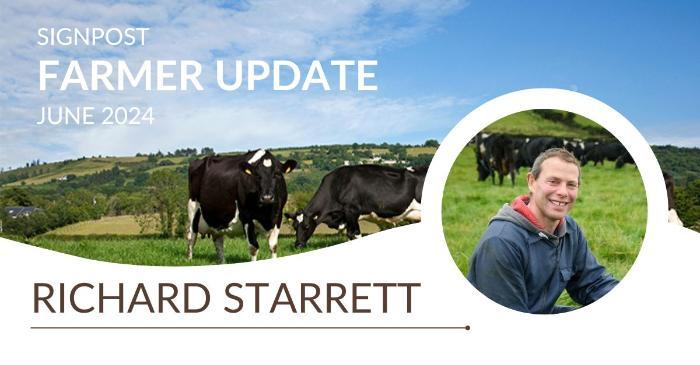Richard Starrett – June 2024
Simple steps to boost biodiversity on the farm without affecting productivity.
As part of the Signpost Programme, we follow the 12 steps to help reduce greenhouse gas and ammonia emissions.
Pollution Impact Potential (PIP) maps have been used to identify potential losses of nitrogen and phosphorous, critical source areas and overland flow paths, all with the aim of improving water quality.
More recently, we had a biodiversity assessment of the farm carried out. I went along to find out what was involved.
The average field size was an important measure, and it is determined by biodiverse boundaries such as a hedgerow, stonewall, drain, earth bank or grass margin, rather than the paddock layout.
In other words, a fence does not count as a biodiverse margin. My average field size came to 2.8ha (6.9ac).
There is a target figure of less than 5ha, and our low figure highlights the good connectivity or biodiversity corridors throughout the farm.
It is important to mention that over the years, we have decided not to remove boundaries in order to increase paddock size, but we have also increased cow numbers.
Where you have mixed-sized paddocks, it is very important to allocate grass correctly. We manage this by splitting cows between paddocks during the day, ensuring that each cow is allocated 21kg dry matter per day as total intake.
The reason we split during the day as opposed to night, is that a batt latch is used in the morning, so from 6am onwards cows can start making their own way to the parlour.
The biodiversity assessment also takes into account hedgerow management, and we found that 53pc of the hedgerows on the farm are topped, while 47pc are tree-line. The ideal mix is 50:50 so that a range of different biodiversity will benefit.
Our topped hedgerows are important in providing cover for mammals and are kept to a height of at least 1.8m to allow birds to nest.
In recent years, most of the topped hedgerows have been cut to leave a bevelled edge at the top, rather than flat.
We also leave a sapling every 300m on the topped hedgerows in line with Derogation requirements.
We keep the hedgerows topped on the roadway between the main road and the yard.
This roadway is a long incline, and if we get frost or snow, light needs to get down to the road to thaw it out, as we need access for both the milk truck and ourselves.
Tree-line hedgerows are side-trimmed only; this type of hedgerow is important in supporting nest sites for birds.
A recent visitor to the farm from the national biodiversity data centre spotted a yellowhammer in one of the hedgerow. This is a great find, especially given that the yellowhammer has declined by 58pc in the last 20 years.
Overall, the assessment has shown that we have many measures in place to maintain and increase biodiversity.
The inclusion of an extra 400m of new hedgerow between 2023 and 2024 will increase biodiversity further.
The PIP water quality maps are a great tool in deciding where to put new hedgerows, because they can identify areas where sowing a hedge will benefit water quality, while increasing biodiversity and creating shelter for livestock.

